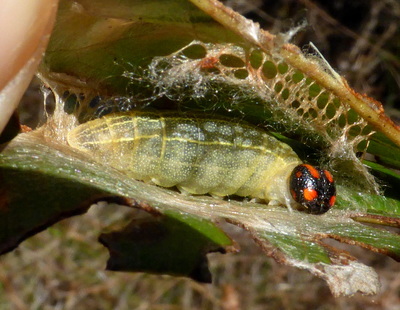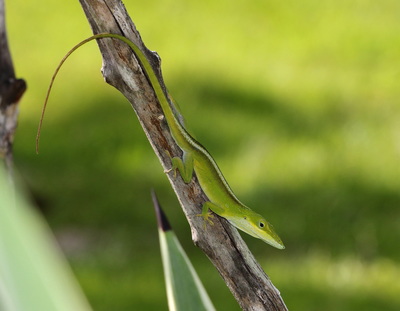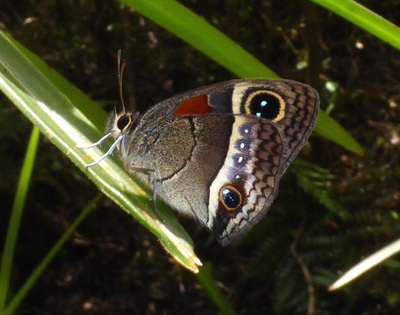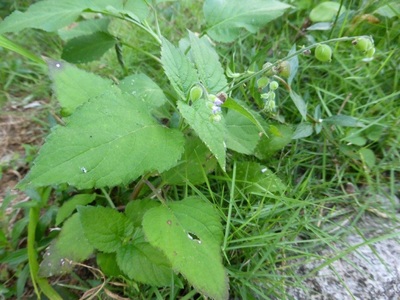|
Early in the morning Lynn had a swim in the Miraflores hotel swimming pool. It had a green film over the surface and she was surprised there weren’t any ducks there as they would have loved it! We set off east from Moa towards the Alejandro de Humboldt National Park. Moa is a nickel mining town and many of the people staying in the hotel were in the mining industry. The mining is open cast and this was plain to see in the area east of the town as it is done on a large scale. We were told by Leandro that we were not allowed to take photos here presumably because this is not the picture of Cuba that the authorities want to show. We made a couple of stops further on once we were beyond the mines and here we noticed a steady trickle of butterflies moving north including Gray Cracker Hamadryas februa, Great Southern White Ascia monuste, White-angled Sulphur Anteos clorinde and Cloudless Sulphur Phoebis sennae but best of all was a single Silver-studded Leafwing Hypna clytemnestra. This was a first for me and although it didn’t stop I had a clear enough view to be sure. Both Polydamas Swallowtail Battus polydamas and Cuban Kite Swallowtail Eurytides celadon with its distinctive blue colour flew past and we watched Mimosa Yellow Pyrisitia nise laying. There was also a small number of the endemic Orange-washed Sulphur Phoebis avellaneda. The road from Moa is paved as far as a few km beyond Yamanigüey but from there on is just a dusty stoned track so the going is much slower until a few km before you get to Baracoa. When we arrived at the NP reception building there was a small statue of Humboldt himself. We paid a small fee and picked up our guide Leuvis Alpajón who would take us into the park for the rest of the day. It was hot and the tracks were steep and there were shallow rivers to cross though some of us managed this without removing our shoes and using the stepping stones. Only a short distance from the road Doug noticed a blue which he disturbed from a Stigmaphyllon and because this is the foodplant of Miami Blue Cyclargus thomasi he suspected that it was this species. We had to climb the bank to clinch it and there were three nectaring on the bushes above. Later in the day Doug found a larval shelter of Florida Duskywing Ephyriades brunnea which uses the same hostplant. The large larva had spun two leaves together and was sheltering between them. It was hot and the track was steep in places but there were constantly new things to see including several species of Anole. Whilst Anolis porcatus is a widespread species Anolis rubribarbus is found only in this small region of eastern Cuba. Both are endemic to the island though A. porcatus has also been introduced to Spain and Tenerife! The third species that we saw was a Cuban Trunk Anole Anolis argenteolus. Our path took us through the river several times though it wasn't very deep and I managed to keep my shoes on and not get my feet wet. There are eleven species of Calisto described to date, all endemic to Cuba, and the commonest and most widespread of these is the Cuban Calisto Calisto herophile. There are several others in this area and we managed to see two of them Calisto bruneri and Calisto dissimulatum. In all our visits to Cuba to date we have only seen a Mosaic Colobura dirce once and never seen the immature stages. The larvae feed on Cecropia which is a common enough tree and so its always worth checking the leaves. On this occasion there were two small egg batches laid on the upper sides of the leaves. This tree is also used by Stinky Leafwing Historis odius but this lays its eggs on the leaf-tips or undersides of the leaves not on the upper surface. Some good birds were in evidence today - lots of Cuban Tody were calling in the forest, a pair of Western Spindalis came quite close and a family party of Cuban Green Woodpeckers searched for grubs in the branches just over our heads. We heard Cuban Trogon calling for much of the time and I got what was probably my closest views ever though unfortunately partly obscured by vegetation. The best was saved till almost last when a Cuban Checkerspot Atlantea perezi flew off ahead of us and settled much too briefly. It didn't like the ultrasound from the camera and this was the only shot that I got before it flew off into the forest and disappeared completely. This was one of the species that we had come to see and it was at one time thought to occur only here at the eastern end of Cuba but has since also been seen near Topes de Collantes in the Escambray Mountains and so is presumably resident there too. It was disappointing to get just one rather rubbish shot of this absolute stunner. We did see it at another site later in the trip but it was even less obliging. A small damselfly that I photographed here, and not surprisingly didn't recognise, has been identified subsequently as another endemic Hypolestes trinitatis. After saying our goodbyes to Leuvis for an excellent afternoon we drove on eastwards to Villa Maguana which is an absolutely delightful place to stay with lovely accommodation, excellent food, beautiful sea to swim in and very friendly staff. We checked into our rooms, quick wash and change and out into the garden to explore while there was still light before dinner. Doug was quick to find larvae of Potrillo Skipper Cabares potrillo in larval shelters on the foodplant Priva lappulacea which was growing just outside our rooms.
3 Comments
7/9/2017 04:42:24 pm
Natural <3
Reply
Tim
7/9/2017 08:11:15 pm
Yes, all the close-ups and scenic shots were taken with a Panasonic Lumix TZ40 while the birds, reptiles etc were taken with a Canon 7D with a Canon 70-200 f2.8 IS II
Reply
13/5/2018 07:24:28 pm
Wow great pics and great eye to have those clicks
Reply
Leave a Reply. |
Welcome to our Blog
Here we will post interesting news about what we and others have seen in Cuba. Archives
July 2024
Categories |




























 RSS Feed
RSS Feed